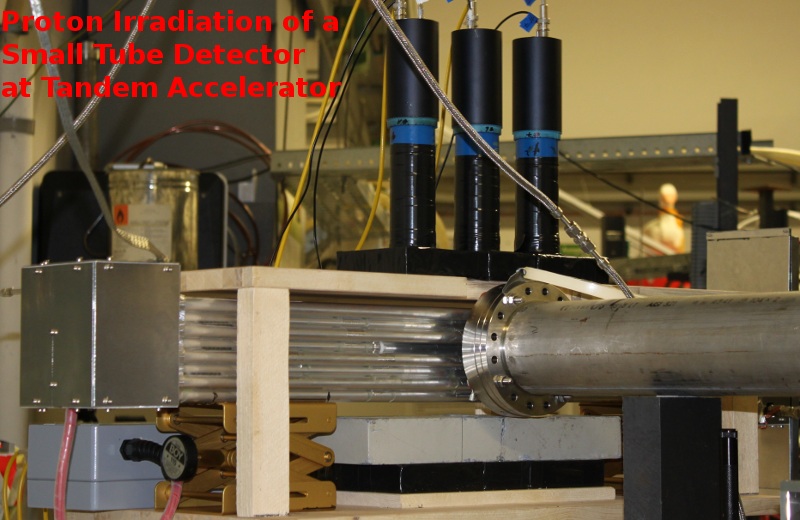Tandem irradiation facility
Two dedicated experimental areas at the tandem laboratory are used for proton or neutron irradiation of detectors. Beam currents between sub-picoampere and microampere are possible. For the neutron production deuteron breakup on light nuclei is used. This allows for high-energy neutron fluxes of up to 107Hz/cm2 with average energy of 11MeV and an energy spread of 5MeV.
Proton Tracking
![]()
Proton tracking capabilities of four low-material budget floating strip Micromegas are tested with 23MeV protons. The detector behavior with different argon and neon based gas mixtures and the single plane track inclination reconstruction method (μTPC method) are investigated. Combining the tracking information with a particle energy information from the multi-layer scintillator detector enables ion radiography imaging.
Proton Irradiation
 A protoype muon chamber of small-diameter (15mm) drift-tubes is exposed to 20 MeV protons to study the rate-capability of the hardware and the electronics. Two selected tubes in the middle of the array are irradiated from the side with protons on an area of 7 cm x 0.3 cm with rates of up to 2 MHz. The non-irradiated tubes in the other layers provide precision muon tracking. The segmented trigger allows to disentangle rate-effects due to space-charge effects or electronic limitation of rate.
A protoype muon chamber of small-diameter (15mm) drift-tubes is exposed to 20 MeV protons to study the rate-capability of the hardware and the electronics. Two selected tubes in the middle of the array are irradiated from the side with protons on an area of 7 cm x 0.3 cm with rates of up to 2 MHz. The non-irradiated tubes in the other layers provide precision muon tracking. The segmented trigger allows to disentangle rate-effects due to space-charge effects or electronic limitation of rate.
A 64mm x 64mm floating strip Micromegas was laterally irradiated with 550kHz 23MeV protons. Four reference Micromegas, sandwiching the detector under test, provided cosmic muon track information with an accuracy of 50μm. The excellent high-rate capability of the floating strip Micromegas was shown, no space-charge or charge-up effects were observed.
Neutron Irradiation
Neutron irradition with rates of 107 Hz/cm2 of Micromegas detectors and a 15mm drift tube detector with trigger on cosmic muons. The neutron-flux is almost homogeneous in a cone with 60 degrees opening angle.
PSD and Neutron Detectors
Pulse shape discriminating scintillators, developed for the high-rate neutron irradiation, together with BF3 neutron counters allow for unfolding the gamma- and neutron fluxes. Thus accurate irradiation diagnostics is possible.

